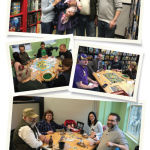But video games take it a step further, helping patients forget that they are doing physical therapy at all. The Wii video game system—in which players mimic what a person on the screen is doing—is now being used commonly by physical therapists for patients with many rheumatic conditions, such as RA. But Dr. Iversen thought a game could be more finely tailored for RA, and more effective.
In work she is doing with Northeastern colleagues Yingzi Lin, PhD, and Jeffrey Breugelmans, a PhD student, the connection with the computer is made using a cyberglove with sensors, which detects movements based on the amount of resistance the computer program is calculating. It also involves an eye tracker—the system knows where you’re looking based on infrared light bounced from the computer to the eye, and back again.
The eye tracker involves no wires, but the glove, at this point, still includes a wire, although it is long enough so that patients can move freely.
Breugelmans is now developing a computer game that he hopes will be interesting to RA patients while encouraging them to perform movements that will be therapeutic for them.
In the game, patients find themselves on a tropical island. By flexing their fingers, they can walk forward. By moving their eyes, they can change the view of the island that appears on the screen. With a bend of the wrist, they can bring up a view of an island map, seen from the top down as though you’re holding it like a tourist. The map includes points of interest that the player might want to visit—getting there, of course, by flexing those fingers.
Throughout the island are tropical “games” to play, such as picking up coconuts with a gentle pinch of the fingers and throwing them at targets, or taking a boulder to a hill and rolling it down.
The island theme is a careful choice. “The game is meant to be relaxing and not meant to put stress on the user,” Breugelmans says. “So there is no time limitation and they’re not forced to do anything—but they can if they want to.”
The game can be modified to require greater flexing in order to do the movements, so that it grows with the patient as the patient becomes capable of more. Healthy people have found the game easy to use, but it has not yet been tried in RA patients, he says.


